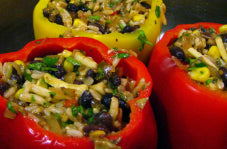Whole Wheat
 0
0
 2013-11-11
2013-11-11

WHOLE GRAIN - WHEAT
According to studies Indians are 3 times more likely to have heart disease as compared to other Asians. Are we just born with unlucky genes? Not really. What we eat and our lifestyle account for 40 per cent to 80 per cent of our health risks.
NUTRITIONAL VALUE
Wheat is nutritious and particularly rich in protein and various vitamins and minerals. The standard industry usage of wheat is in the form of refined flour which is a 60 percent extraction. When wheat is refined the bran and germ are removed, along with all their nutrients. The 40 percent that is removed contains half of all the fiber, vitamins and minerals of wheat.
Products made from whole wheat are recommended because they still possess the natural and nutritious goodness of wheat. A serving of wheat provides 73 grams of carbohydrates about 12 grams of fiber, 14 grams of proteins and no more than 2 grams of fat.
HEALTH BENEFITS
- When we consume whole wheat, we are eating the entire seed (kernel) which is made up of 3 key ingredients; the outer fibrous bran; the endosperm which is the largest part of the kernel and the germ which contains considerable amount of vitamins and minerals.
- Breads, pastries and cakes made with whole wheat have a denser and closed texture. Sweets made from whole grain flours tastes the same as with refined flours, along with the added benefit of good health.
- Most of us already know that eating whole wheat flour is better than eating refined flour because whole grains are more nutritious and contain more insoluble fibre. That means easier digestion, staying satiated longer, and fending off diabetes and heart disease.
- If you want to include more whole grain in your diet, try these easily available, extremely nutritious and inexpensive grains – amaranth, foxtail millet, brown top millet, Kodo millet, Oats, Broken wheat and good-old Ragi.
In general, whole grain flours spoil faster than intact grains, because their protective bran layer has been broken up and oxygen can reach all parts of the grain. If stored properly in airtight containers, most whole grain flours will keep for 1 to 3 months on a cool, dry pantry shelf or 2 to 6 months in the freezer.
HOW TO CONSUME
Whole Wheat can be consumed in many ways – as our Indian rotis, as International bread, as a base for snacks like samosas, biscuits, cakes, etc. It is a very versatile grain, you can use it as replacement wherever refined flour is called for.
PRECAUTIONS
Now- a- days we like to buy “brown”. Brown bread, brown rice, brown rice flour, brown pasta…. the list is endless. But have we stopped to think, is brown always beautiful? Don't let brown in colour fool you because some manufacturers add caramelized sugar to change white refined products to look like whole grains. Check all food labels carefully to see if you are consuming actual whole wheat/whole grain products. Look for the word "whole" in front of the type of grain listed as the first ingredient on the list. Exceptions are rolled oats and brown rice that are always whole. Some breads list “Whole wheat, Wheat…” The second reference to wheat means refined wheat. Also be aware of less desirable added ingredients, like preservatives: E280 -283 known to cause migraines, skin rashes and gastrointestinal issues, added sugar: “no added sugar” means that some ingredients have sugar pre-mixed into them. The same goes for preservatives and Trans fat.
Contributed by
Durga Menon, is a baker and firm believer in eating healthy. She has been running LLUVIA BAKERY , an entirely whole wheat bakery, for the last 4 years. Baking bread is her passion and has been reaching out to health enthusiasts through her home delivery business.LLUVIA BAKERY – contact nos: 8105162111/ 9379969122, https://www.facebook.com/lluviabakery .

 Joybynature.com Team
Joybynature.com Team

